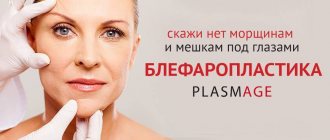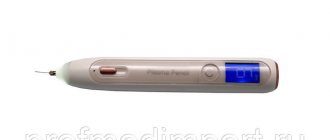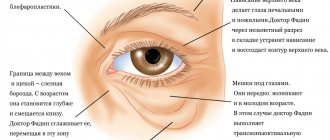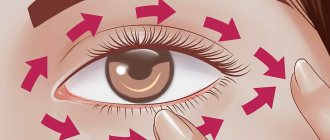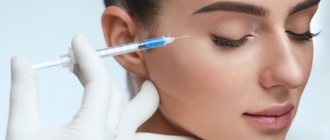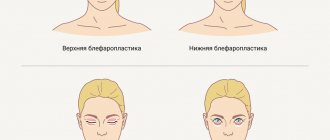Photos before/after blepharoplasty
View all photos
What is blepharoplasty
Blepharoplasty is eyelid surgery. It solves the following problems:
- drooping of the upper eyelid due to excess skin, but not due to drooping eyebrows, which can only be solved by lifting the upper area of the face;
- bags under the eyes , also known as fatty hernias;
- sagging or inversion of the lower eyelid.
I perform this operation most often as part of periorbital rejuvenation or total facelift, and very rarely in isolation. It is important to understand that blepharoplasty does not rejuvenate:
Eyelid surgery
Blepharoplasty in Krasnodar is currently quite popular.
Patients of all ages, both women and men, resort to eyelid surgery. The eyes are involved in facial expression. The expression of the eyes is largely determined by the condition of the eyelids and periorbital tissues. Typically, the first signs of aging appear around the eyes. The skin, thin in this area, stretches, becomes flabby, and muscle tone decreases. The fat surrounding the eyeball extends under the thin skin of the eyelids, forming characteristic protrusions, the so-called “fat hernias”. Excess skin on the upper eyelids can result in a loose fold. Sometimes the crease even falls on the eyelashes, which can limit the field of vision. Constant involuntary tension of the frontal muscles, aimed at raising the eyebrows to reduce sagging eyelid skin, leads to deep transverse wrinkles on the forehead.
Eyelid surgery (blepharoplasty) allows you to eliminate some signs of aging, as well as correct changes that cause the effect of a “tired” look. The usual result is a more alert and lively look with less sagging and puffiness around the eyes. The operation does not affect wrinkles in the corners of the eyes, bruises under the eyes, or swelling above the cheeks. Sometimes the reason for sagging skin of the upper eyelids lies in the low position of the eyebrows, and in this case it is better to do not an eyelid lift, but a brow and forehead lift. Modern cosmetic blepharoplasty does not simply involve the removal of excess skin, but includes a variety of maneuvers aimed at eliminating age-related changes in the entire periorbital area. No, and there cannot be a single way to eliminate cosmetic defects in the structure of the eyelids, suitable for all clinical cases. In his practice, plastic surgeon V.B. Karpyuk uses an individual approach and can perform the following types of blepharoplasty and periorbitoplasty: a) removal of excess skin of the upper eyelids with or without fatty hernias; b) elimination of excess skin of the lower eyelids with or without fatty hernias; c) moving the drooping outer corner of the eye; d) elimination of fatty hernias of the eyelids without excess skin; e) creating a natural fold of the skin of the upper eyelids; f) strengthening or raising the eyebrows; g) elimination of deep tear trench; h) laser resurfacing of eyelids. These steps can be performed simultaneously in a specific sequence
Preparing for surgery. Your first visit to a blepharoplasty specialist in Krasnodar is a detailed consultation. You state your wishes, and the specialist explains in detail all aspects of the operation. During the consultation, it is necessary to discuss in detail with the surgeon the expected effect of the operation. He will order a preoperative examination. If you have vision problems, chronic conjunctivitis, or dysfunction of the lacrimal apparatus, you will need to consult an ophthalmologist. Two weeks before surgery, you must stop taking medications that increase the risk of bleeding (aspirin, etc.). If possible, you should refrain from smoking.
Operation. Modern blepharoplasty in Krasnodar is a safe surgical procedure that is performed under local anesthesia with the preliminary administration of tranquilizers and analgesics an hour before surgery (premedication). The operation lasts from half an hour to 2 hours, depending on the extent of the intervention. The operation begins with marking the incision line. On the upper eyelid, this line follows a natural furrow or wrinkle in the skin and therefore remains invisible. The incision usually extends slightly beyond the edge of the eye. Excess skin and a strip of underlying orbicularis muscle are removed to make the upper eyelid crease more prominent. Excess fat tissue that forms “fat hernias” is then removed. The skin is sutured with a cosmetic suture. On the lower eyelid, the incision is made just below the eyelashes. As with the upper eyelids, it protrudes slightly beyond the edge of the eye. The skin along with the muscle is separated downward, releasing the underlying fatty tissue. Its excess is removed or distributed along the lower edge of the orbit to make the infraorbital tear groove less deep and thereby smooth the transition between the lower eyelid and the cheek. Excess skin and muscle are identified and removed. The muscles at the outer corner of the eye are sometimes pulled up and sutured in a new place to lift and strengthen the eyelid and prevent the lower eyelid from being pulled down while it heals. The wound is sutured with a cosmetic suture. In younger patients who have excess fat in the eyelids but no excess skin, removal of the fat alone is sufficient. This uses an internal transconjunctival incision and therefore leaves no visible scars. If you use laser eyelid resurfacing, you can tighten the eyelid without incisions and get rid of fine wrinkles around the eyes.
After operation. The patient stays in the clinic for several hours or one day. For the first hours, a light pressure bandage is used on the eye area and cold. At this time, it is useful to sit or lie down with your head held high. When the local anesthetic wears off, minor pain may occur. During the first days after surgery, swelling will increase, reaching a maximum on the 2-3rd day. Cold lotions with a solution of furacillin or a decoction of herbs are useful. Usually the sutures are removed on the 3rd or 4th day. Until this time, physical activity, especially straining and heavy lifting, should be avoided. You should not wear contact lenses for the next two weeks. After 10 days, you can use normal makeup. You should wear dark glasses for another 1-2 months, protecting your still sensitive eyes from the sun.
Complications and risks. There may be a slight change in the shape of the eye, with slightly more of the white visible. This condition usually resolves on its own within a few weeks or months. A rare complication is ectropion, i.e. inversion of the lower eyelid, which requires surgical correction. Asymmetry usually exists preoperatively. Patients, as a rule, do not notice uneven gaps between the eyelids or asymmetry in the location and depth of the eyeballs. Surgery may reveal or even enhance pre-existing changes. Another type of asymmetry may occur due to uneven postoperative scarring. Postoperative swelling goes away on its own within a few days, but in some patients it can last longer - up to one month. “Bruises” under the eyes disappear quickly: after 2-3 days they turn pale and yellow, and after 10-14 days they disappear completely. More dangerous may be hemorrhage inside the orbit, leading to increased pressure on the eyeball and further, sometimes very serious, complications affecting vision. To prevent this, medical supervision is necessary in the early postoperative period. Surgery can provoke an exacerbation of existing diseases, which is why it is so important to undergo a thorough examination by an ophthalmologist before surgery.
Upper blepharoplasty
Upper blepharoplasty solves the problem of drooping upper eyelid due to excess skin and fatty tissue.
Algorithm for performing the operation:
- marking is carried out;
- an incision is made along the natural fold of the upper eyelid;
- excess skin is excised;
- the orbicularis oculi muscle is dissected and excess is removed;
- adipose tissue is redistributed or excised;
- an intradermal suture is performed.
This is called resection upper blepharoplasty . Since there are no other types, the word “resection” is often missed.
Blepharoplasty
The first thing we pay attention to when meeting a person is his eyes. All emotions - joy, anger, irritation, amazement - we can read in the gaze. Or do we just think we can? Often, due to age-related changes, drooping tissue and the appearance of bags, a person’s gaze becomes gloomy and tired. Expensive creams and decorative cosmetics are used, but often this is not enough. The eyebrows droop, the upper eyelids droop, and “fatty” hernias form in the lower eyelids.
Blepharoplasty is an operation to correct the appearance of the upper and lower eyelids. Blepharoplasty or eyelid surgery will help get rid of wrinkles, bags under the eyes and drooping eyelids, making your look open and youthful. The need for blepharoplasty is due to changes in the skin of the eyelids and weakening of the orbicularis oculi muscles, which results in sagging of the eyelid and the appearance of fatty “hernias” and numerous wrinkles around the eyes. The advantage of eyelid surgery is that the effect of the operation extends to the entire face, the person looks younger and more attractive.
Meanwhile, blepharoplasty is indicated not only for people in adulthood. Young girls and boys also often suffer from bags and “heavy” eyelids due to their facial structure, and more often after significant weight changes. In these cases, we also recommend aesthetic correction of the lower eyelids, which will help restore the look to its former radiance.
Eyelid surgery is one of the most “delicate” operations in plastic surgery. During the operation, excess skin and fatty hernias are removed. In young patients who do not have excess skin, the “bags” can be removed without resorting to external access, i.e. without incisions - transconjunctivally.
Indications for blepharoplasty:
- excess skin of the upper and lower eyelids (overhang);
- protrusion of “fatty tissue” in the area of the upper and lower eyelids (“fat bags of the eyelids”);
- wrinkles in the lower eyelid area;
- drooping lower corners of the eyes;
- deep folds in the lower eyelid area and in the corners of the eyes;
- desire to change the shape or shape of the eyes.
Contraindications to blepharoplasty:
* increased arterial or intraocular pressure * dry eyes * thyroid diseases * diseases of the cardiovascular system and other serious diseases of internal organs * diabetes mellitus * cancer * bleeding disorders
Types of blepharoplasty:
- upper eyelid blepharoplasty - lower eyelid blepharoplasty - transconjunctival blepharoplasty - canthopexy
Blepharoplasty requires the surgeon to have a sense of proportion and jewelry skill. A qualified specialist is obliged to comprehensively assess the causes of age-related and other changes in the periorbital area. It is necessary to skillfully differentiate situations in which sagging of the upper eyelids occurs due to drooping of the eyebrows and/or forehead due to age-related changes or, as a complication after irrational injection in the frontal and/or glabellar area. As for the lower eyelids, when assessing changes in this area, it is necessary to take into account changes in the midface. Often, simultaneous correction of the midface is required when performing lower blepharoplasty. Relevant at this stage of development of plastic surgery is the tendency to perform “fat-preserving” operations when correcting the lower eyelids. A distinctive feature of such techniques is that during the operation, partial or complete redistribution of fatty hernias of the lower eyelids is performed, instead of removing them. This allows for optimal, natural, long-term results, as well as tear trough repair if necessary.
Blepharoplasty has virtually no age restrictions. However, there are a number of contraindications: progressive visual impairment, severe cardiovascular diseases, diabetes, blood diseases, etc. Blepharoplasty is performed under both local and general anesthesia. In cases where plastic surgery was performed under local anesthesia, the patient can leave the clinic on the same day.
The rehabilitation period is quite easy.
After blepharoplasty surgery, the sutures are removed on the third or fourth day, and strips are applied. Strips are special narrow adhesive strips of flesh color. They are needed to hold the edges of the cuts in the desired position. They are removed on the seventh day after blepharoplasty. After about one to two weeks, all swelling and bruising disappear. They are natural side effects after any surgery. Don't worry too much. The scars may still be slightly noticeable. But, already on the tenth day, it is allowed to use makeup, which can easily hide minor marks of bruises. Rehabilitation lasts up to 2 weeks, but, as a rule, after a week patients return to their normal rhythm of life. Scars become completely invisible after two to four weeks, but the final results of blepharoplasty can only be judged after 1.5 months from the date of the operation. The rejuvenating effect obtained after surgery can be maintained for ten to 15 years.
When blepharoplasty , there are practically no complications.
Contact the Laser Medicine Center! Don't let fatigue be the only expression on your face!
Lower blepharoplasty
Lower blepharoplasty solves the problem of bags under the eyes and sagging/turning of the lower eyelid .
There are two types of lower blepharoplasty depending on the access:
- Transcutaneous (aka resection);
- Transconjunctival.
Incision options for lower blepharoplasty: transcutaneous and transconjunctival
The advantage of the transconjunctival approach is an invisible suture, which is located on the inside of the lower eyelid. Therefore, transconjunctival blepharoplasty is called “blepharoplasty without stitches.”
The advantage of the transcutaneous approach is the ability to remove excess skin:
Transcutaneous lower blepharoplasty
If you want to delve deeper into lower blepharoplasty, read my article with detailed anatomy and surgical technique.
How to remove bags under the eyes? Lower blepharoplasty or fillers.
Non-surgical blepharoplasty in Krasnodar
Today modern cosmetology helps preserve the beauty and youth of your own look. We are talking about non-surgical FT-blepharoplasty of the eyelids . With this unique procedure, there is no need to worry about surgery, incisions or a long recovery period. This manipulation took the best from its operational counterpart and made it as safe and effective as possible. Today, men and women can sign up and undergo the procedure without wasting time and immediately return to their normal lifestyle.
FT-blepharoplasty (non-surgical blepharoplasty) is a unique technique that has no analogues, which is performed on the Fotona device using combined methods of minimally invasive reconstruction of the skin of the eyelids and periorbital area of the face. Fotona's patented laser techniques are used sequentially within a single procedure.
Fotona laser devices are the result of extensive research and more than 50 years of experience in studying laser technology (Fotona was founded in 1964, just four years after the invention of the laser).
Over the many years of its activity, the company has created and patented a large number of FT technologies (Fotona Technologies) and programs that cannot be found on any device from other companies. Such developments allow procedures to be carried out as efficiently as possible. At the same time, it is always possible to adjust the settings so that the treatment takes into account the individual characteristics of the patient.
With the help of this procedure, the collagen framework of the skin of the eyelids is restored, the drooping eyelid is noticeably reduced, the tone and turgor of tissues increases, wrinkles, hyperpigmentation and venous stasis are eliminated, the problem of excessive swelling, hernias of the periorbital zone, circles and bags under the eyes is solved.
Why choose this method?
- The problem is solved in one session within an hour.
- You don't need to spend a long time to recover.
- It is quite painless and absolutely safe for the eyes.
- No injuries or cuts.
- The effect lasts from a year to several years, depending on individual characteristics.
CONTRAINDICATIONS:
- pregnancy, breastfeeding;
- diabetes;
- epilepsy;
- bleeding disorders;
- age under 18 years;
- autoimmune diseases.
Specialists at the Eva-Clinic Center for Cosmetology and Preventive Medicine have developed several individual protocols for the FT-Blepharoplasty procedure, depending on the individual characteristics of the patient, the degree of age-related skin changes and taking into account the possible rehabilitation period.
If you want to smooth out wrinkles in the periorbital area, tighten your eyelids, open your eyes and do it as naturally as possible, make an appointment with the Eva Clinic doctors.
The use of both hardware and injection methods allows you to achieve impressive results. For example, with the help of a laser, you can quickly restore tone and health to the skin, and the injection method (mesotherapy, fillers based on hyaluronic acid, plasma gel) allows you to eliminate circles under the eyes, smooth out fine wrinkles, and contribute to more elastic and hydrated skin.
Eva-Clinic uses only certified equipment and registered drugs. The clinic’s doctors undergo ongoing training in Russia and abroad. The professionalism of a doctor is the key to your beauty and health.
Fat-sparing blepharoplasty
Age-related decrease in the volume of fatty tissues on the face and their migration under the influence of gravity
With age, the volume of fatty tissues on the face decreases and moves downward under the influence of gravity, forming hernias. Therefore, it is necessary to remove orbital fat when performing eyelid surgery according to strict indications. Most often, fat needs to be redistributed to restore the “youthful” position. Read more about the mechanisms of formation of lower eyelid hernias and the technique of fat-sparing lower blepharoplasty in my article.
How to remove bags under the eyes? Lower blepharoplasty or fillers.
Recommendations after blepharoplasty:
1. Antibacterial therapy 5 days 2. Lotions with furatsilin 5-6 times a day for 15 minutes, 3-4 days, then 3-4 times a day (you can use cool tea bags, anti-inflammatory medicinal herbs - chamomile, St. John's wort) . 3. Avoid heavy physical activity and heavy lifting for 2 weeks after surgery. 4 weeks after surgery you can return to your usual physical activities. 4. The suture line is treated with 40% alcohol (vodka) 1-2 times/day 5. For 3 days after surgery, the eyelids should not be wet. 6. Driving is prohibited for the first 5 days after surgery. 7. During the waking period, it is better to lie down as little as possible and bend over as little as possible. When going to bed during the first week after surgery, place your pillow higher.
Prices for blepharoplasty
| Plastic surgery | price, rub. |
| Upper blepharoplasty | 97 000 ₽ |
| Lower blepharoplasty, resection or transconjunctival, including canthopexy if indicated | 97 000 ₽ |
| Circumferential blepharoplasty, upper and lower blepharoplasty, including canthopexy if indicated | 147 000 ₽ |
| Periorbital rejuvenation Circular blepharoplasty + endoscopic lifting of the upper and middle areas of the face + lipofilling + correction of the upper eyelid levators, corrugators, nasolacrimal trough using own tissues | 375 000 ₽ |
| Lipofilling eyelids | 55 000 ₽ |
All types of eye plastic surgery (blepharoplasty)
All signs of aging, various hernias and bags will disappear, the look will become more expressive and beautiful, and the eyes will take on a more pleasant shape. Lower eyelid surgery is performed exclusively above the skin and subcutaneous layer, without affecting the eyes in any way, so such surgical intervention will not affect vision in any way.
Upper blepharoplasty - plastic surgery of the upper eyelids
Upper blepharoplasty is an operation that involves correction of the upper eyelids for aesthetic and anti-aging purposes. Upper eyelid surgery is the most effective way to restore a youthful and open look.
During the operation, the surgeon makes a small, thin incision in the natural fold of the skin of the upper eyelid. Next, excess skin is removed, as well as fat in the affected area; After this, the doctor begins to model the muscles that close and open the eyes, and corrects the functioning of the ligaments.
The next stage of the intervention is the application of cosmetic stitches, which are not visible to the naked eye. In some cases, when there is weakening of the eye muscle, it is fixed (canthopexy).
Lower blepharoplasty - plastic surgery of the lower eyelids
Lower blepharoplasty is an operation that involves correction of the lower eyelids to obtain an aesthetic and rejuvenating result.
With classic lower blepharoplasty, the surgeon makes an incision along the line of the lower eyelid, through which the excess amount of fatty tissue is removed and the remaining is moved to a new position. Next, the skin is excised and tightened. If necessary, correction of the lower eyelids is performed simultaneously with canthopexy or canthoplasty.
If the patient has fatty hernias and at the same time there is no excess skin, transconjunctival blepharoplasty is performed. This method of eyelid correction is characterized by access from the inside of the lower eyelid. It is also possible to redistribute fat through intraoral access, for which the doctor makes a puncture on the oral mucosa. Both tanconjunctival and blepharoplasty using the intraoral approach do not leave visible scars or scars.
Circular blepharoplasty - plastic surgery of the upper and lower eyelids
Circular blepharoplasty is an operation that involves simultaneous correction of the upper and lower eyelids. This type of intervention makes it possible to undergo double rehabilitation in a minimum period of time.
Circular blepharoplasty today is performed using a combination of classical and transconjunctival methods. During the operation, the surgeon makes an incision in the skin in the area of the upper and lower eyelids. The incision on the upper eyelid is made along its natural crease, as a result of which the seam subsequently becomes almost invisible.
The impact on the lower eyelid is performed in two ways: along the eyelash growth line (external method) or on the mucous membrane of the eyelid (internal/transconjunctival method). Through the incisions, the surgeon removes the excess amount of intraorbital fat, after which he resects the excess skin in the eyelid area. Next, the skin is tightened, fixed in a new position, and cosmetic sutures are applied. It should be noted that, thanks to the features of modern blepharoplasty techniques, it is possible not only to remove, but also to redistribute the volume of fat in the eyelid area.
Canthoplasty - changing the shape of the eyes
Canthoplasty is a type of eyelid surgery that involves changing the shape of the eyes to European or Asian. During the correction, the corners and lower part of the eyelids are tightened.
In the crease of the eyelid, the surgeon makes an incision about 10 millimeters long, through which he gets to the tendon. Next, he moves and secures it in the desired position using self-absorbing threads. If necessary, excess tissue is excised. The operation is completed by applying sutures and a disinfecting bandage.
Canthoplasty is a low-traumatic type of blepharoplasty, so it can be performed on an outpatient basis without the patient staying in the clinic for 24 hours after surgery.
Transconjunctival blepharoplasty
Transconjunctival blepharoplasty is a method of seamless surgical intervention in which access to the underlying skin structures is through the conjunctiva, without trauma to the skin of the eyelid. This method is considered one of the most gentle and effective. Patients experience virtually no pain, and the rehabilitation period is only 7-10 days.
Despite the fact that all manipulations are performed in close proximity to the eye, they do not affect visual acuity in any way. But it should be remembered that if you have farsightedness, myopia and other ophthalmological diseases, you should definitely tell your doctor about it.
The duration of all manipulations rarely exceeds 1-1.5 hours. Both upper and lower transconjunctival blepharoplasty are performed under local anesthesia, which ensures complete painlessness for the entire period of the operation. The patient is discharged from the hospital after 5-7 hours.
Singaporei - blepharoplasty of Asian eyes, Europeanization of eyes
Singapuri is a surgical operation aimed at changing some of the structural features of the eastern eyes. Correction of the Asian eye shape can be carried out if a person wants to bring the shape of his eyes closer to the European one.
Blepharoplasty of Asian eyes is a rather complex procedure that requires special training and practice from the surgeon. Each case is individual, it all depends on the extent of the changes needed.
There are 2 ways of performing the operation. The first is called the “incision technique” and involves incisions in the natural crease of the upper eyelid. This is how a double supraorbital fold is formed. Next, the surgeon, having gained access to the localization site, performs excision of excess skin and fatty tissue of the upper eyelid. Then both edges are stitched layer by layer. At the last stage, the surgeon fixes everything with threads and applies a continuous cosmetic suture. If necessary, the epicanthus (folds of skin at the inner corner of the eye) is also removed.
The second method is the suture technique. It is suitable for those patients who do not have very pronounced Mongoloid eyelids, as well as for those who have very thin skin of the upper eyelids. A 1 mm incision is located on the inside. During this operation, a supraorbital fold is also formed. However, after that all layers of tissue between the tendon of the upper eyelid muscle and the skin are stitched. This is what strengthens the fold. Sutures are placed through tiny punctures in the skin of the eyelids.
Preparing for surgery
Before eyelid surgery, you must first consult with the plastic surgeon who performs this intervention. Find out from the doctor about the nuances of future correction that interest you, asking him all your questions.
If you cannot meet with a surgeon, we draw your attention to the Online Consultation service. Ask any question about blepharoplasty and receive an answer from the surgeon within one business day.
No less mandatory conditions for all types of eyelid surgery are undergoing a routine medical examination and testing.
Postoperative period
After the operation, a bandage is applied to the eyes. When the anesthesia wears off, you may experience throbbing pain. Tissue swelling and bruising disappear within two weeks. Very rarely, increased lacrimation, thinning of eyelashes and changes in vision are observed. These phenomena disappear within a month.
You can go outside in 1-2 weeks. You just need to avoid direct sunlight and use sunglasses.
Cost of the operation
The price of eyelid surgery (blepharoplasty) depends on the complexity of the surgical intervention. The full cost of the operation is determined by the surgeon at a preliminary consultation, when he gets to know you better and conducts an examination.
___
Initial appointment with a plastic surgeon - 1,000 rubles.
Carrying out the operation - from 20,000 rubles. (canthoplasty)
Other expenses - find out the full receipt of the all-inclusive operation from the clinic administrators by phone. 8 (863) 2-372-000
